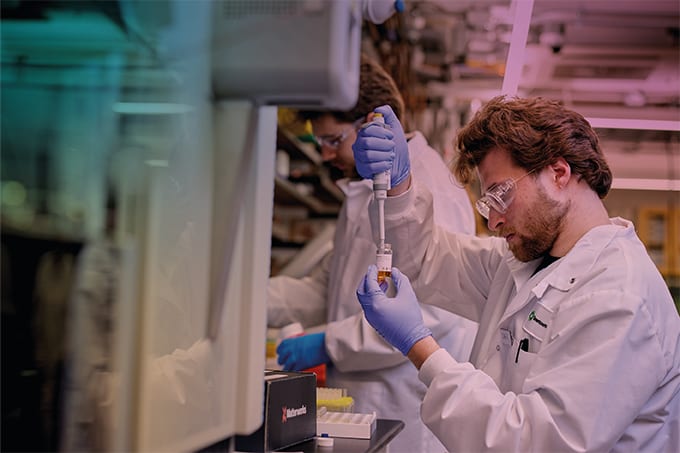Dealing with the data deluge is a top priority for the modern laboratory. Information must be managed such that users can collect, organize, extract and analyze data in ways that improve productivity, reproducibility and decision-making. This is exactly what the Laboratory Information Management System (LIMS) aims to do – as a digital backbone that structures and streamlines everything from sample tracking and workflow automation to regulatory compliance and data analytics.
With labs facing increasing sample volumes, complex regulatory demands, or ambitious digital transformation goals, it is no surprise that LIMS adoption is increasing. But how do you know when the time is right to invest in a LIMS? What challenges can the latest AI and automation-enabling solutions solve – and what pitfalls should be avoided?
We asked three seasoned LIMS specialists to share their perspectives on when, why, and how labs should adopt and implement these powerful platforms.
Meet the Experts
Richard Danielson is the Principal CEO of Danielson Applied Consulting LLC. He has a PhD in environmental and public health microbiology; and he specializes in the development and application of bioinformatics tools to enhance laboratory operations and data management.
Dan DeHoney is Vice President of SaaS LIMS at LabWare, where he leads the development and deployment of scalable, industry-specific laboratory informatics solutions.
Denise Bell is the Director of Product Management at LabVantage Solutions, with over 25 years of laboratory experience and more than 13 years in IT, focusing on LIMS and LIS implementations.
Where can LIMS add value?
Dan DeHoney: LIMS drives efficiency, accuracy, and compliance across multiple sectors. For example, in regulated industries, compliance with FDA, ISO, and GMP standards becomes effortless. In clinical labs, LIMS ensures traceability of patient samples and compliance with regulations. In research labs, it enhances the reproducibility of experiments and data integrity. Environmental labs can manage large sample volumes efficiently while meeting regulatory requirements. And in manufacturing QC labs, LIMS automates data tracking, minimizing errors and improving production quality. A modular, enterprise-grade LIMS with proven deployment models can significantly reduce costs through fewer errors, less manual work, better resource allocation, and improved turnaround times.
Denise Bell: LIMS adds value in many ways: it automates workflows to reduce manual tasks and human error; it centralizes data to provide a single source of truth and improve accessibility; it maintains audit trails and generates reports to meet regulatory standards; it enables real-time data sharing across departments and locations; it minimizes inefficiencies and lowers the risk of compliance penalties; and it provides insights for resource planning, performance optimization, and trend analysis.
LIMS has clear relevance across many types of laboratories. To add to the examples Dan mentioned: food and beverage labs, LIMS ensures quality control and ingredient tracking; oil and gas labs use it to test chemical compositions and ensure environmental safety; and in pharmaceutical and biotech settings, it supports compliance and clinical trials.
Implementing a LIMS delivers clear ROI by automating routine processes, cutting sample processing times, minimizing manual entry errors, and boosting accuracy and compliance. It reduces audit risks and penalties through improved regulatory alignment and optimizes resources by enhancing instrument usage and workforce efficiency. With real-time data, teams can gain faster insights, which in turn enables quicker, more informed decisions and improved forecasting.
Richard Danielson: Yes – in a nutshell: by increasing efficiency and reducing common errors, a LIMS enables greater output and allows laboratories to take on higher workloads.

When should you start thinking about a LIMS?
DeHoney: A LIMS should be considered early – ideally before operational pain points begin to emerge. If your lab is starting to scale, dealing with data inconsistencies, struggling with workload demands, or coming under increased regulatory scrutiny, implementing a LIMS can help prevent bottlenecks before they compromise performance.
Early adoption is particularly important for new or startup labs. Deploying a flexible, cloud-capable LIMS from the outset establishes a solid foundation for future growth and regulatory readiness. It also demonstrates operational maturity, which can be a valuable signal to partners, clients, and investors.
Labs that implement a well-matched LIMS typically see measurable improvements in efficiency, data quality, and compliance. That said, the success of a LIMS implementation depends heavily on selecting a platform with proven flexibility, reliable vendor support, and strong implementation expertise.
Bell: If you're facing challenges such as growing sample volumes or increasing workflow complexity, it’s definitely time to invest in a LIMS. As the number of samples rises, manual tracking becomes inefficient, and the complexity of workflows demands automation to maintain both accuracy and speed.
A LIMS is also essential when your lab must comply with strict regulatory standards – such as those set by the FDA, ISO, CLIA, or under GxP guidelines – which require detailed audit trails and strong data integrity. Many labs struggle with data management and traceability, especially when working across multiple spreadsheets or disconnected systems. Version control issues, duplicate records, or even lost data can quickly derail operations, and a centralized system helps address all of these problems.
In addition, when reporting becomes time-consuming or lacks transparency, or when real-time visibility into sample status and workflow efficiency is lacking, a LIMS can step in to provide actionable analytics and faster, more confident decision-making.
Finally, manual data entry is a red flag. When errors and rework become common, it’s a sign that standardized, automated processes are needed to ensure reliable, consistent outcomes. Similarly, if your lab is expanding and current systems can’t keep up – or if you need to integrate with ERP platforms or analytical tools – then a LIMS can support both scalability and digital transformation.
Danielson: Agreed – if you’re still handling your data manually, it’s time to get a LIMS. Manual systems quickly become unsustainable, especially as labs grow or face more complex regulatory demands. But before engaging with vendors, you must clearly identify what you need the LIMS to do. Defining your lab’s specific requirements allows you to compare systems meaningfully and choose one that aligns with your operational needs.
How well do labs understand LIMS, and how can they bridge the knowledge gap when choosing the right system?
DeHoney: Understanding of LIMS varies widely across labs. Some users see it purely as a tool for sample tracking, while others recognize its potential as a central platform for process control, regulatory compliance, and digital transformation. Bridging that knowledge gap is essential for a successful rollout.
In my view, LIMS should be part of lab training in universities – that foundational exposure is often missing. Vendors also have a crucial role to play by offering demos, hands-on training, and ongoing support to help users grasp both the practical and strategic value of the system.
To prepare for selecting the right LIMS, labs should begin by clearly defining their requirements. This includes identifying regulatory compliance needs, as well as integration requirements with instruments and software like ERP systems, ELNs, or analytical platforms. Labs also need to estimate their expected sample tracking volume to ensure the system will scale with their operations.
Engaging all key stakeholders early in the process is key. That includes lab managers, IT teams, quality assurance personnel, regulatory experts, and end users like technicians and analysts. Their input ensures the chosen LIMS meets real operational needs, integrates smoothly with existing systems, and remains user-friendly for daily workflows.
Scalability is another critical factor. Labs should choose a system that can grow with them – supporting larger sample volumes, multiple sites, and evolving compliance needs. A scalable LIMS should offer modular upgrades, flexible configurations, and cloud-based deployment options that can adapt over time.
Finally, it’s important to prioritize vendors with strong reputations for customer support and system flexibility. A well-supported LIMS should come with comprehensive training, responsive technical assistance, and a commitment to continuous innovation – helping labs stay aligned with the latest advances in digital lab management.
Danielson: Once introduced, most end users tend to learn only the parts of the LIMS that relate directly to their own tasks. That limited understanding can be enough to get by day to day, but it often means the system's full capabilities go underutilized. To truly benefit from a LIMS, lab managers need to budget time as carefully as they budget money – dedicating resources not just to the purchase of the system, but also to learning how to use it effectively.
I agree that educational institutions could certainly play a stronger role by introducing LIMS concepts and workflows earlier in scientific training. But beyond that, internal training, clear communication, and strong vendor support are all crucial for closing the knowledge gap.
When preparing to choose the right system, the most important step a lab can take is conducting an extensive needs assessment. Understanding your lab’s specific workflows, challenges, and long-term goals is essential before evaluating vendors. Only then can you identify the right fit and ensure the LIMS will support your operations both now and in the future.
Bell: Some customers know the basics of LIMS – things like data tracking and sample management – but, as Richard said, few understand the full scope of what the system can do. Many don’t realize that a well-designed LIMS can integrate directly with lab instruments, automate complex workflows, and significantly improve regulatory compliance.
To address these gaps in understanding, we offer webinars and hands-on training sessions, along with clear documentation and ongoing support. In many cases, labs benefit most from tailored workshops that focus on their specific workflows and needs, helping them connect system functionality with real-world application. And yes – given that most scientists aren’t taught how to manage data efficiently or use digital systems like LIMS, even basic training in LIMS as part of university-level science education would go a long way in preparing future lab professionals.
To Richard’s point about preparing to select the right system, labs should begin by mapping out their current workflows and identifying areas where time is lost or mistakes are common. Creating a clear list of “must-haves” and “nice-to-haves” is also helpful when evaluating vendors. Most importantly, it’s critical to involve end users early in the process – they’re the ones who will be working with the system every day, and their input can help ensure a better fit and smoother implementation.

How has LIMS technology evolved in recent years, and what are the standout features of today’s systems?
Bell: LIMS has undergone significant transformation over the past five years, driven largely by digital transformation, the rise of cloud technologies, increasing automation, and growing demands for compliance and AI integration. SaaS-based LIMS solutions have gained considerable traction, offering labs greater scalability, lower upfront costs (shifting from CapEx to OpEx), and reduced IT burden thanks to secure, cloud-hosted infrastructure with automatic updates and maintenance.
AI-driven predictive analytics are now helping labs detect trends in sample data, optimize workflows, and forecast capabilities. We're also seeing the evolution of conversational interfaces and AI-assisted tools for data validation and anomaly detection. Seamless integration with IoT and ERP systems enables truly end-to-end workflows – reducing manual data entry, improving accuracy, and streamlining operations. Built-in compliance features like automated audit trails, e-signatures, and real-time compliance tracking make it easier for labs to stay aligned with regulatory requirements and respond swiftly to potential violations.
In the latest versions – such as LabVantage 8.9 – the focus is on speed, productivity, flexibility, and intelligence. AI-driven insights can now identify anomalies and suggest process improvements automatically. User interfaces have become more intuitive, reducing training needs and making systems easier to navigate. Compliance tools have also become more advanced, offering real-time reporting and detailed audit logs to support regulatory needs.
Cloud-based platforms now offer greater scalability and data security, while enabling remote access and faster deployment of updates. Increased automation across sample tracking, data collection, and reporting reduces human error and improves efficiency. Modern LIMS also integrate seamlessly with ERP systems like SAP, lab instruments, and data analysis platforms, enhancing connectivity across the lab ecosystem. With full mobile functionality, lab managers can even monitor and adjust workflows on the go.
LIMS has truly evolved from being a “nice-to-have” to becoming a strategic asset that drives lab productivity, improves compliance, and supports better decision-making.
Danielson: Over the past several years, LIMS vendors have shifted toward offering cloud-based solutions. Rather than relying on traditional, on-premises installations with one-time software purchases, most vendors now favor subscription-based models. This change supports more flexible deployment, lower up-front costs, and easier system maintenance.
Recent developments have also focused on mobility and accessibility. Integrated mobile applications allow lab personnel to work more freely, without being tied to a specific location. Data collected in the field can be uploaded directly into the LIMS, reducing transcription errors and speeding up the sample log-in process.
Client-facing features have also become more advanced. Modern LIMS now offer portals where labs can assign permissions to clients and organizational contacts – giving them secure access to their own data, reports, invoices, and more. These portals also allow clients to notify the lab of incoming work and submit essential sample information or electronic chains of custody in advance, so that the lab is fully prepared before the samples even arrive.
DeHoney: As Denise and Richard have said, the latest versions of LIMS include embedded AI-driven analytics that provide predictive insights and support faster decision-making. Secure, single-tenant cloud and SaaS deployment options are now widely available, offering flexibility and enhanced data protection.
LIMS platforms also feature secure IoT integration, enabling real-time data streaming from connected instruments. Role-based security, audit logs, and compliance enforcement tools are built in to help labs meet regulatory requirements.
Automated workflows are designed to scale – from a single laboratory to global enterprise environments. In addition, API-rich architectures allow for interoperability across a broad digital ecosystem, ensuring that the LIMS can integrate with other systems as part of a connected lab infrastructure.

Top Do’s and Don’ts for Choosing and Implementing a LIMS
Do:
● Clearly define your lab’s requirements using a structured approach like SMART criteria to guide system evaluation (DeHoney)
● Conduct an internal needs assessment before contacting vendors – know exactly what problems you’re solving (Danielson)
● Build a detailed requirements document with input from cross-functional focus groups (Bell)
● Include all key stakeholders early– lab staff, IT, QA, and management – in the evaluation and decision-making process (DeHoney, Danielson, Bell)
● Compare LIMS vendors using a requirements scorecard to assess how well each option meets your specific needs (Bell)
● Choose a scalable and flexible platform that can grow with your lab and adapt to future workflows or integrations (DeHoney)
● Ensure thorough training is provided for all users to boost adoption and reduce frustration (DeHoney)
● Evaluate how well the system integrates with existing instruments, ERP systems, or other software (DeHoney)
● Request vendor demos using your real data to assess how the system handles your workflows (Danielson)
● Plan for long-term maintenance, support, and user feedback as part of the implementation strategy (DeHoney)
● Prioritize Change Management – communicate openly about changes, address concerns, and provide ongoing support to ease transition. (Bell)
Don’t:
● Choose based solely on cost – focus on long-term value and functionality instead (DeHoney)
● Neglect training or assume IT will handle everything – input from lab users is essential. (DeHoney)
● Over-customize the system to the point that it becomes inflexible or difficult to maintain (DeHoney)
● Skip pilot testing – running a small-scale implementation first can reveal critical issues (DeHoney)
● Underestimate the time and effort required from lab staff during setup and transition (Danielson)
● Ignore built-in compliance features – these are critical for audit readiness and regulatory alignment (DeHoney)
● Delay system updates or maintenance, which can create security and performance risks (DeHoney)
● Assume all LIMS platforms offer the same depth or scalability – evaluate each carefully (DeHoney)
● Settle for the first vendor quote – negotiate pricing and confirm you're not paying for unnecessary features (Danielson)
● Ignore user feedback during implementation, which can lead to low adoption and missed improvements (DeHoney)
● Ignore Data Quality – clean and validate data before migrating and importing (Bell)
● Forget About Integration with instruments, ERP, or other lab systems (Bell)
● Stop after Go-live – implementation is the not the end, continuous improvement, support and training are essential for long-term success (Bell)




